-
Posts
268 -
Joined
-
Last visited
Content Type
Profiles
Forums
Events
Store
Posts posted by Mark Tyler
-
-
On 10/31/2019 at 7:27 PM, Chris Davidson said:
After syncing Couch/Darnell, use the overlap as the start point. You have the Presspool car 3 seconds ahead (imo) of where it should be when syncing it back to the overlap.
I updated the animation, and it seems the main cause of the problem was that the Press Pool car and the Mayors car accelerated away too quickly. I had to tweak a few other items like the McIntire 1 and Altgens 8 photos by a second or two to fit things in, but otherwise nothing else needed to change. Here are a few key frames with the new timings in:
I think this all looks OK, but let me know if something doesn't look quite right in terms of the positions or speeds of the vehicles.
Thanks again for finding this glitch, I doubt I would have spotted it otherwise. Along with the other improvements people have suggested, I think it shows the value of a community effort so anyone can spot my mistakes and suggest improvements (regardless of which side of the debate they are on).
-
2 hours ago, Chris Davidson said:
Mark,
The PressPool car appears (red box gif) within the Couch segment.
After syncing Couch/Darnell, use the overlap as the start point. You have the Presspool car 3 seconds ahead (imo) of where it should be when syncing it back to the overlap.
The timing is as such:
Mark's animation- 25.46 - 26.33(PressPool car enters shadow)= .87sec.
Darnell/Couch overlap to first frame in Couch where the red box(PressPool car) appears= 88 frames
88/24fps = 3.66sec
It only takes 5 frames for the car to enter the shadow in Couch 5/24 = .21sec
It takes .87sec for the PressPool car to enter the shadow in your animation.
.87 - .21 = .66 sec
3.66 .66 = 3sec difference.

That's a really useful spot of the National Press Pool car, Chris, thanks! I hadn't spotted it going under the bridge before, but I think you are right about the 3 second gap, so I will need to do some adjusting to get that sequence correct. This is all within a second or so of Altgens arriving on the right hand side of the road; Hargis departing to get back to his bike; and then Haygood riding between the camera cars.
With the Press Pool car also having sync points with the Bell and Paschall films as previously discussed, this may affect Wiegman and Hester calculations too. Once I have explored this over the next few days I will post the results in the thread.
-
Here is version 1.6 of the Motorcade 63 animation and the technical reference handbook:
https://www.marktyler.org/mc63.html
As well as generally fine tuning things, here are the more notable changes:
I added the Pilot Car, including its brief stop on the Elm Street turn as per the statement in the Warren Commission volume 21 page 579:
https://www.history-matters.com/archive/jfk/wc/wcvols/wh21/pdf/WH21_Stevenson_Ex_5053.pdf
I changed the positions of Orville Nix after I did some more detailed triangulation using his film and the fixed positions of the Dealey Plaza scene.
As per requests, I moved the clock which enabled me to slightly enlarge the map.
I adjusted the Altgens path slightly, so his casual amble around the Newmans conforms more strictly to Bond 4, Cancellare 1, Towner 2, and Bothun 5 which were all seemingly taken within about 10 seconds of each other.
Thank you all for the feedback regarding the previous version, I really appreciate people sharing their knowledge and expertise to help make the work better.
-
21 hours ago, Chris Davidson said:
The time span from the Z447 sync point to the Wiegman "Hester in shadow" Bell sync = 26.83 - 11 sec = 15.83sec.
Applying the same process of progressive frames between sync points, the Wiegman NFV version shows frame 561.
That's a total of 318 Wiegman frames between the sync points.
Remember though, there are 3.47sec (36.5 - 33.03sec) total, missing from the NFV version.
I have already accounted for 20 of those from the previous posting. 20/24 = .83sec
That leaves 3.47 - .83 = 2.64sec missing Wiegman frames between the z447 sync point to the Wiegman "Hester in shadow" Bell sync, which gets added to the existing 318 frames.
Without the missing frames 318/15.83 sec = 20.08 fps
Since the initial Wiegman frame rate up to z447 averages 24fps, I'll use that as the rate for the missing 2.64 sec.
2.64 x 24fps = 63.36 =64 frames
318 + 64 = 382 frames
382/15.83sec = 24.13fps
I believe I'm right in saying that the NFV logo means this is the so called "Groden" version of the Wiegman film. The quality looks good, but as you say there are a few frames missing at the beginning.
On the subject of Wiegman frame rates, it may be useful for readers to see the Wiegman film replayed at various different speeds relative to 24 FPS:
24.0 FPS (100% speed as broadcast on the day of the assassination)
https://drive.google.com/file/d/1Y-Z6gvsWCEUhNd6Zk9-r49F0fAXXZodx/preview
28.0 FPS (116.7%)
https://drive.google.com/file/d/1x40-EjFCeJPde9X7vySoHgCJOnQSbdqO/preview
29.6 FPS (123.3%)
https://drive.google.com/file/d/1BGA2utyAUFyEuOcAXCv6mGi6Gf81CYeV/preview
32.0 FPS (133.3%)
https://drive.google.com/file/d/1sRb3tRblP6yEmv2ri_EzRzjclwz4gqRM/preview
The best place to use as a visual reference is towards the end with Hester jumping to his feet and the people running across the grass at the end.
I judge 24 FPS to be too slow, 32 FPS feels too fast, and 27-30 FPS feels correct in terms of my eyes. Readers may agree or disagree, feel free to let me know either way!
-
15 hours ago, Chris Davidson said:
It may not be the true sync point for Z/Wiegman. And please, don't equate it to my belief that it is.
Eventually, it should fall into place.
Fair enough Chris, I shall go with the flow and reserve judgement until the conclusion of your ideas.
-
On 10/25/2019 at 4:41 PM, Chris Davidson said:
It looks like I included 2 extra interlaced frames in the Paschall span.
The span is 21 frames (21/18.3 = 1.14sec), instead of the original 23. Sorry about that.
Updating the running time count when Paschall and Bell are added after the Bell stop is 18.5 + 1.14 + 2.05 = 21.69sec from extant z313.
So if the gap from Z313 to Hester jumping into the colonnade is 21.69 seconds, then the gap from Z295 (the start of Wiegman filming) is 22.67 seconds.
18 hours ago, Chris Davidson said:The total time from Wiegman's start to the Bell/Wiegman sync (frame after the sunlight on Charles' hand) = 26.83 seconds Seconds Counter = 25/30 = .83
This allows you (deductive reasoning) to compare the sync from "front to back" and "back to front"
This timing seems about right as it was towards the end of the 27.2 second segment of the Wiegman film which was broadcast on the day of the assassination.
Next, we need to solve the problem that I call the "Wiegman timing anomaly" which I outline in appendix C of my book:
https://www.marktyler.org/mc63/mc63_handbook.pdf
In short, there is 2-3 second missing gap between the Wiegman film and the Zapruder film between Z295 and Z447 (if you assume the expected frame rates of 18.3 FPS and 24 FPS for the respective cameras). I solve this issue by changing the recorded frame rate for the Wiegman film from 24 FPS, and moving it higher to match 18.3 FPS between Z295 and Z447. The calculations in this thread (and my animation) use a Zapruder frame rate of 18.3 FPS, which means the early section of the Wiegman film would need to average 31.9 FPS to sync with Z295 to Z447 (see table 4 in the book).
To exactly match the 22.67 seconds mentioned at the beginning of this post we would need to use an average Wiegman rate of about 28.37 FPS, i.e. 24 * (26.8 / 22.67). Ergo:
22.67 = 26.8 * (24 / 28.37)
i.e. Real time = Broadcast time * (FPS factor)
Both 28.37 FPS (total average) and 31.9 FPS (early average Z295-Z447) are in the approximately correct range which I tested in my book using various checks, so this all feels about right to me [1] (given the usual margins for error, etc).
QED
Note [1]: As I explain in the book, cameras of this era were relatively primitive and didn't maintain a constant frame rate, so by Z295-Z447 the Zapruder film was probably running a little slower (the FBI measured Zapruder's camera recording film at an average of 18.3 FPS for the first 30 seconds, and then 17.6 FPS for the final 30 seconds, so the device slowed down as a scene was filmed). In other words, in 1963 the Zapruder camera was probably running slower than 18.3 FPS at that point, and the Wiegman camera was running faster than its usual rate, which is the logic behind pushing the rate up so much at the beginning to 31.9 FPS, which would then fall to 28.4 or lower by the end of the Wiegman film clip being studied.
Caveat: This all assumes the cause of the "Wiegman timing anomaly" was a higher than expected frame rate. Readers may disagree with this, in which case a new interpretation of the 2-3 second gap in the Wiegman/Zapruder films Z295-Z447 will be required. Dale Myers avoids this problem by saying Wiegman started filming at Z246, but this can be proven to be false via the Altgens 6 photo which fails to show the Mayors car in the correct place turning onto Elm Street.
For a good explanation of this problem and the geometry involved, readers should have a look at Pat Speer's online book:
http://www.patspeer.com/chapter6:piecesontheroad
See the section "Where’s Dearie?".
-
On 10/23/2019 at 2:10 AM, Chris Davidson said:
There are a couple of sync points for Bell/Wiegman.
I used Charles Hester and his entry into the colonnade shadow as my sync point.
I lightened him as he appears in the background (just behind the foreground lamp post).
The other sync point is Beatrice moving her left hand/arm off the ground and backwards, if one desires to use this as a sync.
Difference from the Charles sync to the Beatrice sync = 7 Bell to 11 Wiegman frames
The Charles sync span equals 32 Bell frames = 32/15.6 = 2.05 sec.
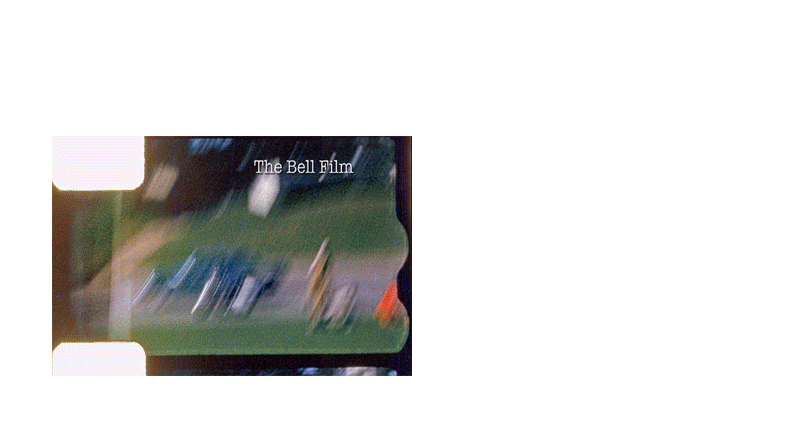
Yes Chris, it looks like Charles Hester jumping into the colonnade is a good synchronization point between the Bell and Wiegman films. I hadn't seen this detail before as I have been viewing poor quality versions of the Bell film, so thanks for sharing it.
Wiegman stops filming here, and dashes down the lawn to film the Newman family as I recall. This run is partially captured by the Couch film, which is crucial as this syncs what is going on on Elm Street, and Baker dashing towards the TSBD.
The film jigsaw pieces are falling neatly into place!
-
On 10/22/2019 at 6:37 PM, John Butler said:
The Altgens 7 photo is rather interesting John, thanks for sharing the version showing the people on top of the overpass (it often gets cropped off). Not only do we see Sam Holland and his friends who saw the puff of smoke on the knoll, there are a number of other useful witnesses visible.
If you look closely you can see the outline of Bill Decker in the rear left of the police lead car looking back towards the action. He said he saw a spray of water come from the presidential limo (presumably Z313), and a bullet bouncing off the concrete, which I think was the final shot around Z400 (roughly when this photo was taken coincidentally). Royce Skelton and Austin Miller are visible on the top of the underpass, and they both reported a bullet hitting the road too. All of this testimony was reported independently on the day of the assassination, so I feel it can be trusted.
If anyone needs more details and references, I explain this shot in section 6.3 and appendix D.8 of my book here:
https://www.marktyler.org/mc63/mc63_handbook.pdf
I think there is a strong chance this final shot was the one that disintegrated and created the shrapnel that hit James Tague as the trajectory is a straight line from the sixth floor, as shown in the animation.
-
On 10/22/2019 at 5:42 PM, Robin Unger said:
Thanks Mark
Zapruder GIF showing the two running men.
 On 10/22/2019 at 5:47 PM, Robin Unger said:
On 10/22/2019 at 5:47 PM, Robin Unger said:This is a rather nice juxtaposition Robin, because it suggests that the man in the light shirt runs across Main Street towards the pickup truck stopped on Commerce Street, while the dark shirted "Duck Man" runs straight up the grass.
About 35 seconds after Z405 Cancellare takes his first photo:
If you look closely behind the same pickup truck, you see a light shirted man, who may well be the same person. Its just a guess of course, but the timing seems a good match as he would have had enough time to take cover as he watched the unfolding chaos on Elm Street.
-
21 hours ago, Chris Davidson said:
Agreed, and with this said, let's also include the times from extant z313 as a running count. This might make it easier for others to follow along.
Z313 - z435 = 122/18.3 = 6.66sec
Bell Sync z435 to Bell Stop = 5.19sec
I believe you have the Paschall start at 18:56 in your animation.
This would equal a gap between Bell stop/Paschall start of 6.65sec.
I would tend to agree, but with a possible difference of .05sec (minimal), which I will not include moving forward.
6.66 + 5.19 + 6.65 = 18.5 sec
Up next, Paschall.
I think this is correct Chris.
That few seconds of the Paschall film is rather interesting, not just for the car but also you can see Zapruder and Sitzman walking away from their position on their perch, which means they took just 5-10 seconds to get down after Zapruder stopped filming. If the animation timings are correct, then it also means that Paschall filmed the knoll area 18.5 seconds after Z313 and the fatal shot.
Greg Jaynes suggests that there was some movement behind the picket fence at that time, and he calculated this to be 16.45 seconds after the fatal shot at Z313:
http://jfk.hood.edu/Collection/Weisberg Subject Index Files/P Disk/P Letter/Item 55.pdf
I've only viewed poor quality versions of this film so I've not seen this movement in detail, only a flicker of light which could simply be tree foliage moving in the breeze. Has anyone else seen the original film?
10 hours ago, Chris Davidson said:I used the bumper of the "national press pool" car for the sync between Bell/Paschall.
The beginning of Paschall until she syncs with Bell = 23 Paschall frames.
The Bell sync frame with Paschall, is also the beginning Bell frame (this will become clearer when I sync Bell/Wiegman) for the next sequence. The Bell frame inset is 1 frame after the sync. I used this frame because it's much clearer in terms of "bumper to stationary object" than the actual sync frame.
She used a Bell/Howell 8mm camera (18fps) according to a 1996 Greg Jaynes analysis.
23/18 = 1.28sec
This looks about right Chris. I have tweaked the timing of my "Bell 3" and Paschell yellow flashes to match your triangulation as it makes things a little easier to understand in the animation. Thanks for the idea! The Paschall flash also syncs the bus turning the corner onto Houston St - its amazing how much useful detail is contained in that few seconds of grainy old film.
On the subject of synchronizations, the Altgens 8 photo was taken around this time too:
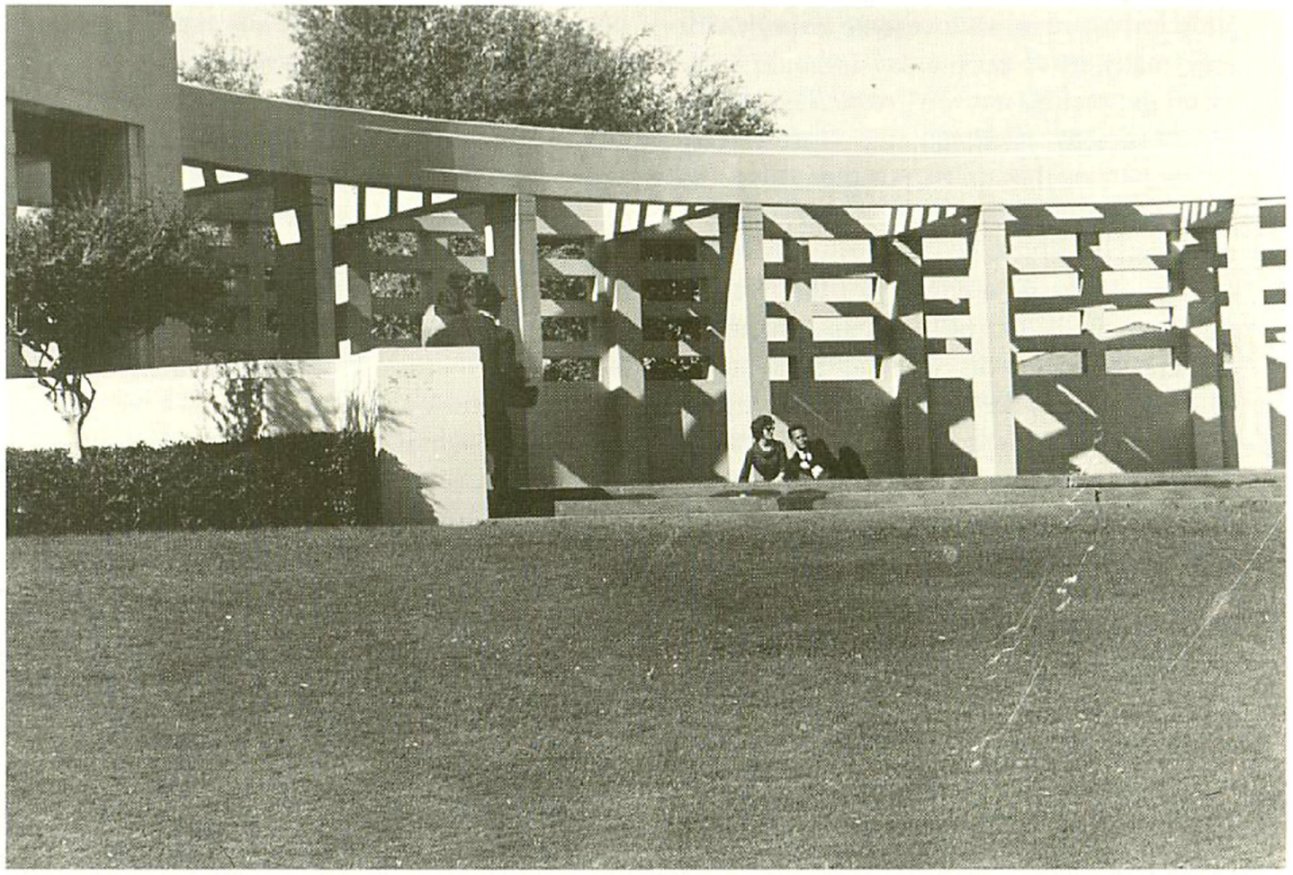
This helps match the Paschell and Bell films as we see Zapruder walking in both. Also, the Wiegman and Bell films due to Charles Hester jumping up soon after Altgens 8 was taken.
-
22 hours ago, Robin Unger said:
Bell Gif
frames taken from "The lost bullet Documentary"

Thanks for the GIF Robin and letting me know the source. What caught my eye was the man on the left hand frame running towards the camera up the grass. I assume this is one of the two people visible in frame 405 of the Zapruder film here:

He seems to be ducking which may relate to being in the direct line of fire for the shot at Z313, or one soon after.
With Tague slightly further to the left of the Bell frame being hit by shrapnel from the Z313 shot, or the shot I calculate as being fired around Z400, its interesting how all three of these people reacted and dashed away from the danger zone so quickly. Does anyone know who this running man was, and whether he was interviewed? I have christened him "Duck Man" until he can be identified properly!
He is also visible in the Paschall and Daniel films, so its a good opportunity to have a chronological overlap of four films: Zapruder, Bell, Paschell, and Daniel. I have just put him into the animation and he seems to be running an average speed of 9 MPH (peaking at 11 MPH) from Z405 to when Daniel starts his film and "Duck Man" has reached the lamppost, which seems plausible for a running speed during the 12 seconds or so after the fatal shot. While not the most important aspect of the crime scene, "Duck Man" does at least corroborate the timings of how the films overlap which is useful for this project.
-
16 hours ago, Chris Davidson said:
The sample range will grow larger as I continue on.
I believe you used 18.3fps(average) for Z, I will stick with 15.6fps (average) which is quite close to its factory spec.
The progressive frame count from my sync point (Z435) to the end of Bell is 81 frames.
81/15.6 = 5.19sec.
This sounds plausible Chris. The Limo travels from the position shown at Z435 to a spot just beyond the shadow of the bridge on the far side in 5.19 secs, which equates to a car speed of 25-30 MPH. At roughly that time Daniel starts recording his film from the other side of the bridge.
After this I think Bell stops for 5-10 seconds (perhaps to wind the camera up again), and when he restarts he catches the National Press Pool car whizzing past the steps on the knoll (just as Paschall did). Then he films Zapruder/Sitzman, Hargis, and Wiegman filming Mr & Mrs Hester.
-
On 10/18/2019 at 1:07 AM, Chris Davidson said:
These are the same frames (albeit from different sources) as Groden's version.
Quality is a little better. imo
Groden's appears to be complete minus a few at the very beginning (before the sync point - not important at this time).
This stabilized (my work) gif is from one of the other sources (one of the countless JFK specials with bits and pieces).
The gif starts with the same Bell frame I equated to the Z435 sync and ends with the underpass sync.
The span = 29 progressive frames.
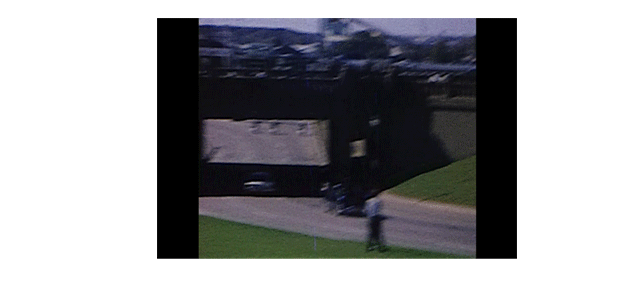
So you think the Zapruder gap is Z435 to Z469 (34 frames), with the Bell gap being 29 frames? If Zapruder was 18.3 FPS then this makes Bell about 15.6 FPS, which seems fairly close to the quoted rate for Bell's camera you mentioned in an earlier post (i.e. 16 FPS).
By contrast if Zapruder was running a bit slower at say 17.3 FPS, then this section of Bell would have been 14.8 FPS. With Zapruder at 17.3 FPS, that makes the Wiegman film about 30.1 FPS between Z295 and Z447.
This is all within acceptable boundaries I would say, both in terms of the cameras and also my study of the Wiegman timing anomaly in section C of the handbook. As always though, there are margins for error, so an extra frame or two here or there will change the ratio dramatically as 29 sample frames is quite a small range.
-
21 hours ago, Chris Davidson said:
That's fine.
Next would be a sync for both films near the underpass.
If you know the Bell (progressive) frame count between this location and the previous z435 location, this will give you a FPS ratio from Bell to Z using 18.3fps per Z.
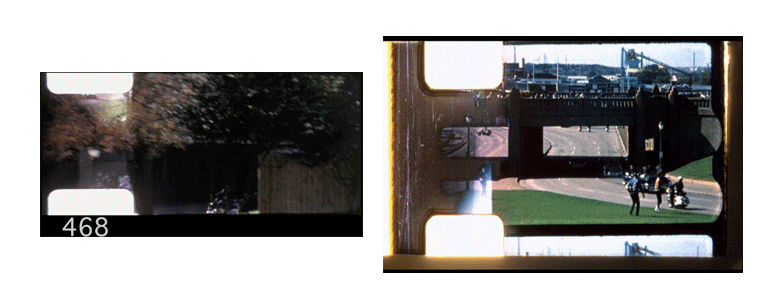
This does sound logical Chris, and the frames you use with the Limo entering the bridge shadow looks synchronized to me. Sadly I don't have access to the original Bell frames, so I can't do any accurate calculations regarding frame numbers (i.e. to get the relative frame rate ratio from Bell to Zapruder). Do you have access to all of the original frames?
-
22 hours ago, John Butler said:
Mark,
I agree the figures down the walk do look smaller that they should if that is Bell. Those figures should be closer to Bronson than those figures north of Elm St. But, they look smaller. It could be some sort of camera distortion thing and an illusion. I guess one could count the sections in the structure. It is a shame that no one on the north side of Elm filmed except Zapruder. Or, was allowed to or keep their film.
John, I think I have worked out what is going on. I think the white pillar furthest away is actually the one north of Elm street as per this diagram:
Interestingly you mentioned the human figures north of Elm street are the same size in your post so I suspect you may have been one step ahead here!
Just for clarity here is a brighter version:
I don't think Marie Muchmore (labelled 70 in the animation frame above) is visible in this photo. She starts filming about 2-3 seconds after the Bronson photo was taken so she may be just to the right of the frame as she dashed across. Here is a view from the other side so you can see more clearly where Muchmore was standing when she took the final scene of her film:
Here is a view of the pillar to the north of Elm Street taken circa Z133, known as Willis 4, with the light pillar side to the left, and the shaded side to the right (matching the Bronson photo):
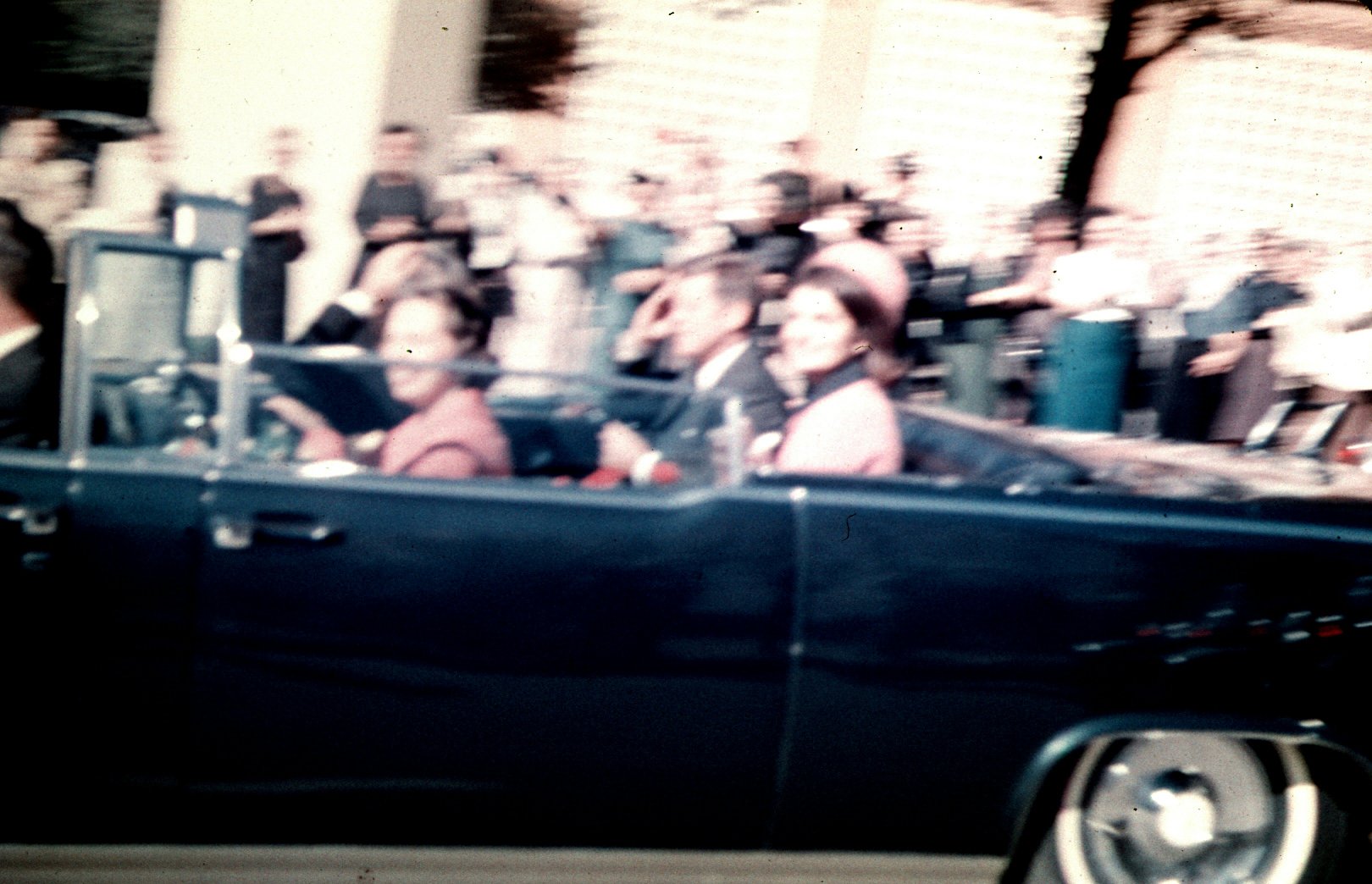
There were about 102 Zapruder frames between this and the Bronson photo, or about 5.6 seconds, so the people may have moved slightly. I don't think this helps with anything in the animation, but its worth putting on the public record just for reference.
-
On 10/15/2019 at 4:30 PM, John Butler said:
It's fairly rough. But, there are two or more people there. One could be the dark suit guy as seen in Skaggs. Probably Bell had the same idea as him or vice versa. It's too rough to say for sure, but is it suggestive.
This is really interesting John. I think the view is looking down the channel, because the human figure looks much smaller than the ones in the foreground. Here is the animation frame for that moment:
70 is Muchmore and 71 is Bond, so they may be involved also. Its a hard photo to read though as the edge cuts off what we need to see for context, so I'm not sure what to make of it. Having said that, the tree between Bronson and the peristyle looks too far to the right on my map, so I will move it to the left a bit. Thanks for the tip!
-
On 10/15/2019 at 4:05 PM, Michael Cross said:
I love this. Collaboration, not being stuck on a position, searching for the truth. Well done.
Indeed Michael, cooperation really helps get to the bottom of these things! Its very easy to get the wrong end of the stick with some of these photos and films, so a fresh pair of eyes is very handy.
-
On 10/15/2019 at 4:00 PM, John Butler said:
Mark,
FWIW, if you watch the Robert Hughes film you will see that there are plenty of Dallas Policemen directing traffic near the intersection of Main and Houston. I would say the Pilot Car arrived at the intersection when traffic was still moving there. And, by the time the motorbikes arrived traffic had been stopped and cleared in that area. Muchmore shows a person walking across the intersection before the motocade arrives there. We don't see the 3 Advance Motorcycles there. What is seen is the 5 Lead Motorcycles. They take the turn in an approved procedural fashion with 3 motobikes first followed by two motorbikes.
I think the first few scenes of the Hughes film were taken some minutes before, but as always, its hard to know due to the cutting between scenes as it could be seconds or minutes each time.
The 5 lead bikes break at some point in main street (all 5 were together in a Paschall sequence, so near Market St I would guess), with 2 of them moving near the advance bikes, which is what we see in Muchmore. Croft 1 shows the remaining 3 in front of the DPD lead car:
Its a bit grainy but its enough proof to show that the bikes in Muchmore were ahead of these ones.
For more references regarding the bike formation have a look at Todd Wayne Vaughan's work here:
http://jfk.hood.edu/Collection/Weisberg Subject Index Files/M Disk/Motorcade Route/Item 15.pdf
-
On 10/15/2019 at 8:42 AM, Chris Davidson said:
Continuing forward:
Would you agree/disagree that these two frames sync?
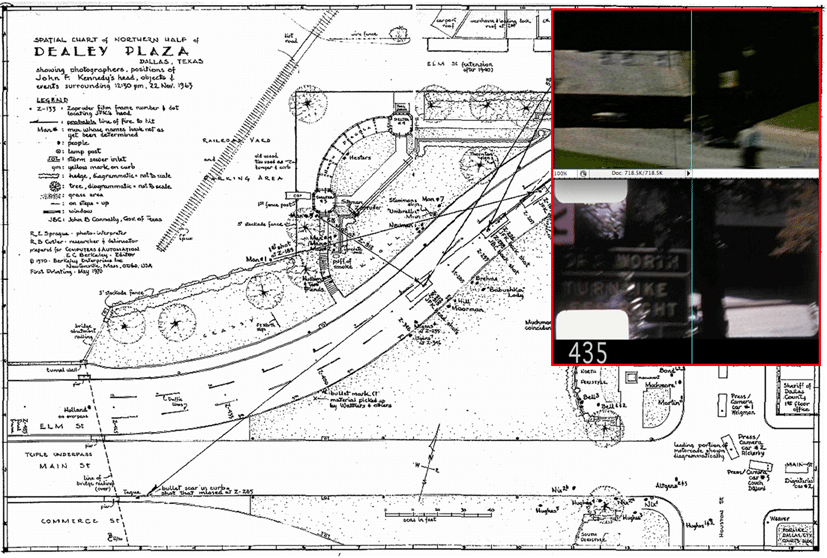
The two frames are close, here is the rendering of the animation at Z435.1:
There is is an optical illusion in the Bell frame. You have triangulated to the nearside abutment in the map, but you should have used the the far side edge because the black area is actually the wall of the tunnel.
Otherwise, yes they are very close in time and within a few frames I would say due to the car moving so fast at this time circa 25-30 MPH.
-
22 hours ago, Chris Davidson said:
You do have the limo position fairly accurate for extant z437(very important). Bell starts filming slightly before that.
Something like this:
I don't think Bell was standing on the grass because this is refuted by the Nix film, the Bronson photo, and the Bronson film. If Bell jumped down from the pedestal at Z133 and scampered along the grass he would have been visible in one of these Bronson images at Z235 and Z330 5-10 seconds later:
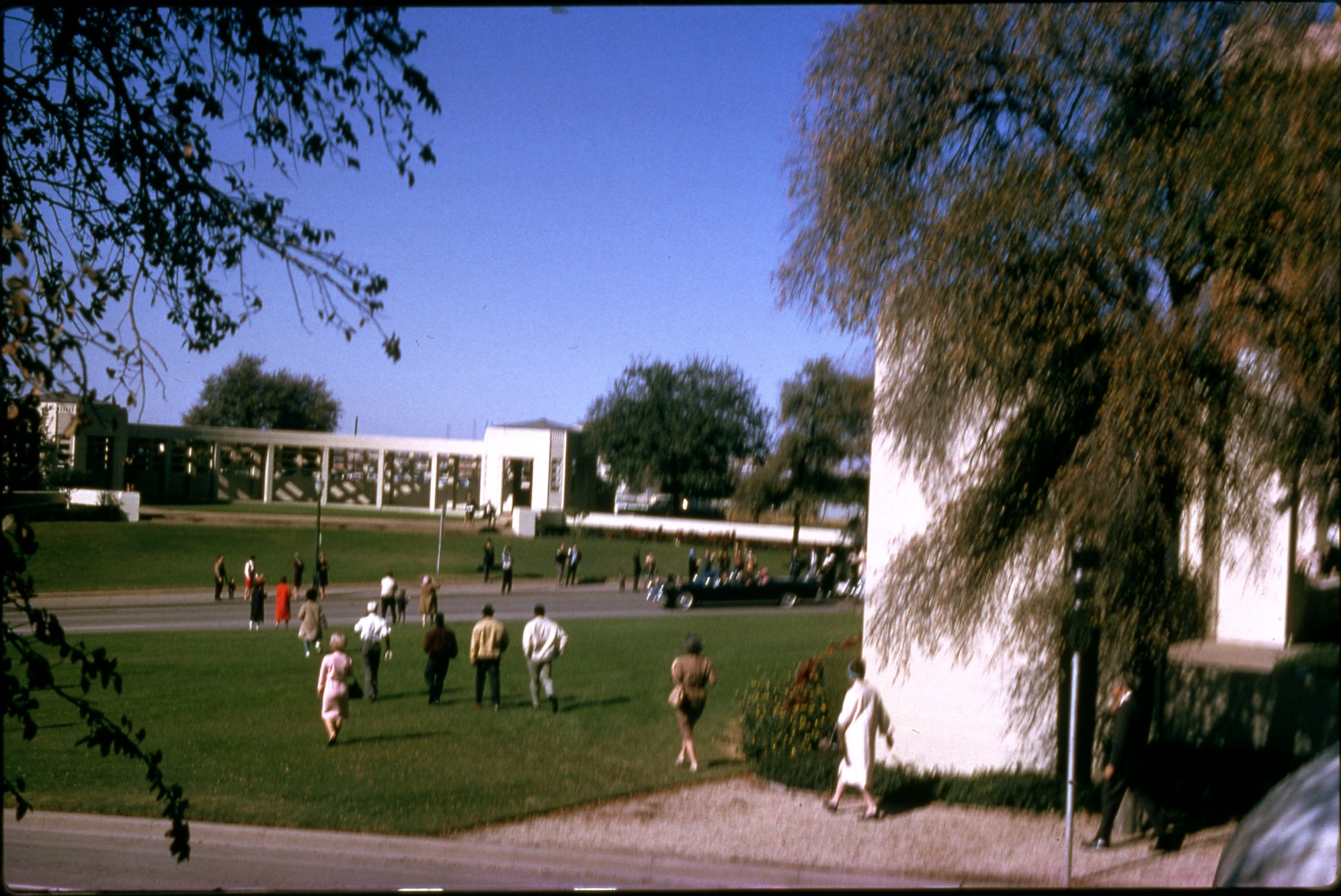
Triangulation for Bell should be fairly accurate, within a few feet I would say, because of various telltale features:
1. The pedestrian tunnel in the bridge is showing a narrow shaft of light from the other side:
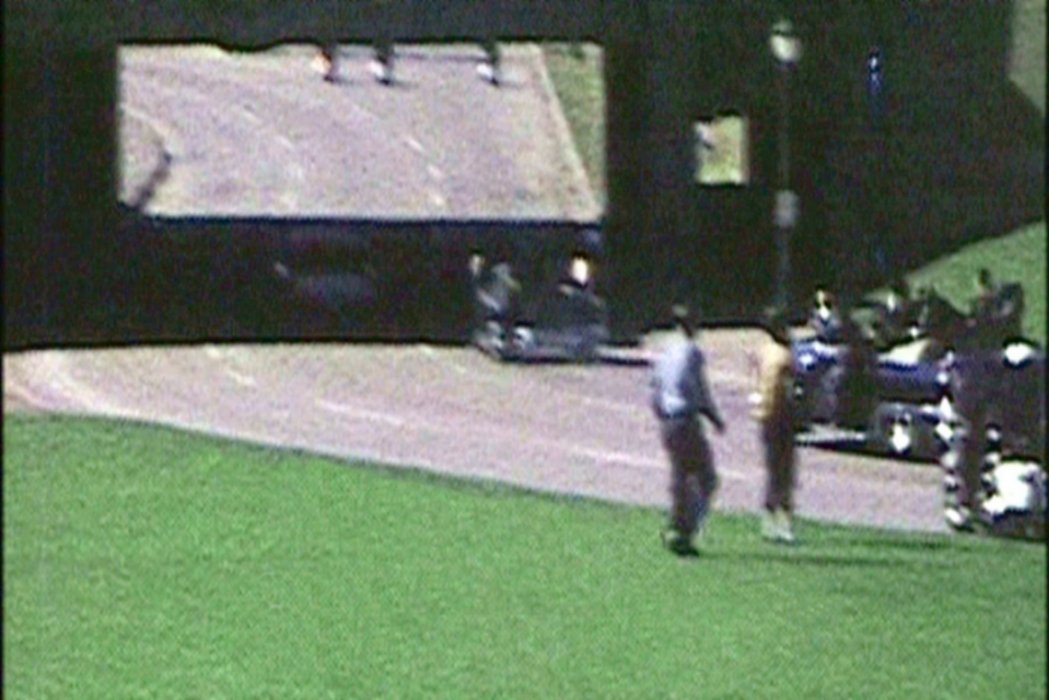
2. The lamppost and sign sit in a specific location relative to the pillars of the pergola:
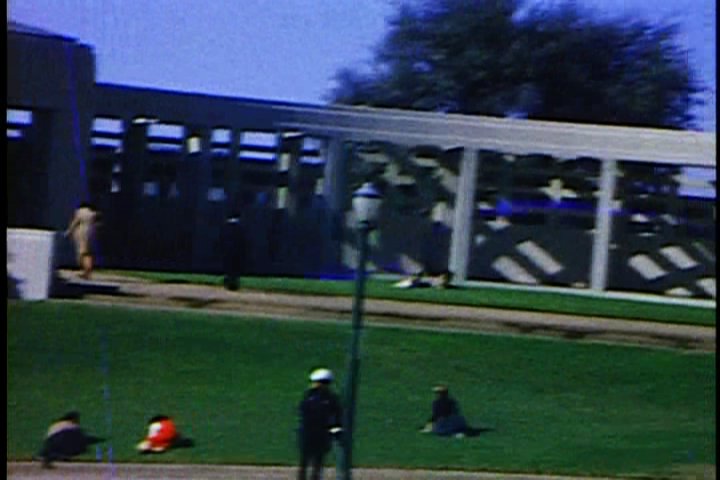
If you trace 3 lines back for each of these frames on the map you should find they all cross over in the alcove in the peristyle that I position Bell in the animation.
The clearest early frame of the Bell film I found was in this video:
Judging from the position of the Limo relative to the lamppost, this is about Z419, so with a few blurry frames before he may have restarted as early as Z410 (within a second of where I think the third shot was fired). As I recall I used the yellow flash at Z460 to catch the 3 lead bikes in the distance, rather than to signify the beginning of the Bell film.
In summary I think my calculations in the animation are correct because:
1. The triangulation places him in the peristyle.
2. Bronson proves he was not running around the peristyle Z235 - Z330.
3. He restarts filming at Z410 which corresponds perfectly in time for him to walk briskly from his first known position at Z133 to the triangulated position for the next sequence of the film at Z410.
-
1 hour ago, Chris Davidson said:
I disagree.
Start with this:
Bell's physical filming location for this segment is incorrect.
Bell's starting time for this same segment (extant z460) is also incorrect.
I calculated the position of Bell by triangulating the fixed positions of the bridge, lampposts, signs, and pergola. Do you think he was perched in a different gap in the peristyle?
Its possible I wasn't using a complete version of the film, which may mean the start point was earlier. Is there a complete version of the film somewhere online?
-
On 10/12/2019 at 2:59 PM, John Butler said:
No problem Mark,
It is my impression that the first car of the motorcade turned off on Market Street you can see the car broadside in the turn.
I agree, I think that the black car turning off is definitely the advanced car: a single occupant; a white car following behind; and bikes about 20 seconds behind the white car all fits exactly with the known motorcade vehicle pattern.
On 10/12/2019 at 2:59 PM, John Butler said:The white Pilot car is see earlier in the film further down Main. I believe, if my memory is correct, that the white Pilot Car is seen in the Muchmore film turning onto Main St. later. As far as I know that particular car is seen only in those films.
Indeed, I've not seen these two cars anywhere else, either in films or photos. The versions of the Paschall film that I have seen do have some early footage of the Market Street area, but then it cuts to the advanced bikes just missing what the AMIPA film shows.
The white car in the Muchmore film is tricky to identify due to timing issues. Specifically, the traffic is flowing around the white car, whereas we know that when the bikes turn the same corner just seconds after the pilot car the traffic has completely stopped and cleared. For example there is a bus parked behind the white car, but when the bikes are turning it has disappeared completely. Therefore I suspect the Muchmore white car was probably filmed a few minutes before the Pilot car appeared.
Either way, we still have enough evidence with the AMIPA film and the Warren Commission testimony to be confident that the white pilot car drove through Dealey Plaza. Pilot car puzzle solved!
-
21 hours ago, Gene Kelly said:
Just an observation, but the AMIPA film shows quite a bit of activity on the Knoll in/around the Pergola prior to the motorcade passage. You can see Zapruder on the pedestal (there exist very few good photos of him) and what appears to be a male standing on top of the Pergola. Has anyone studied that film in detail?
Well spotted Gene, there does indeed seem to be someone perched on the top of the Pergola! He seems to be holding a shovel or something like that.
I think this scene is from the day after the assassination though, as the video description mentions 23rd November for the second part of the video.
-
On 10/6/2019 at 4:08 PM, John Butler said:
2. You need to show the Pilot Car. You don't show this vehicle ahead of the Advance Motorcycles. It is not necessary to show the Advance Car this turned from Main St. onto Market St. and left the motorcade. See AMIPA film.
John, I spent some time reviewing the AMIPA film again frame by frame, and I think you are right about the front two cars. The angles are slightly tricky to judge but I think the black "Advance Car" signals to turn off onto Market Street, and then just after the cut we see the back of the black car finishing the turn. The shadow of the "Pilot Car" is on the road while this happens, and seems to carry on straight ahead towards Dealey Plaza.
I confirmed the location as Market Street with the help of a Jim Walker photo, which is in the Sixth Floor Museum collection here:
https://emuseum.jfk.org/objects/27349/black-and-white-photograph-of-the-presidential-limousine-in
Judging from the "PARK" sign and the building behind on the left, this is the same as the AMIPA film so we have a match which is confirmed by the "Texas Bank" on the opposite side of Main Street. When the Presidential Limo drives past and the camera pans sharply it looks like these are the final few buildings on Main Street before the Old Red Courthouse. Sadly the film cuts at this point.
I'm sorry if my earlier mistake caused any confusion, but after checking frame by frame, and cross referencing with other photos I think this is now correct. With the "Pilot Car" carrying on to Dealey Plaza (about 20 seconds ahead of the bikes) I shall put this into the next version of the animation. This route is confirmed by the driver G.L. Lumpkin who described going through Dealey Plaza in the Warren Commission Volume 21 Page 579:
https://www.history-matters.com/archive/jfk/wc/wcvols/wh21/pdf/WH21_Stevenson_Ex_5053.pdf
Thanks for bringing this to my attention and making the work more accurate!




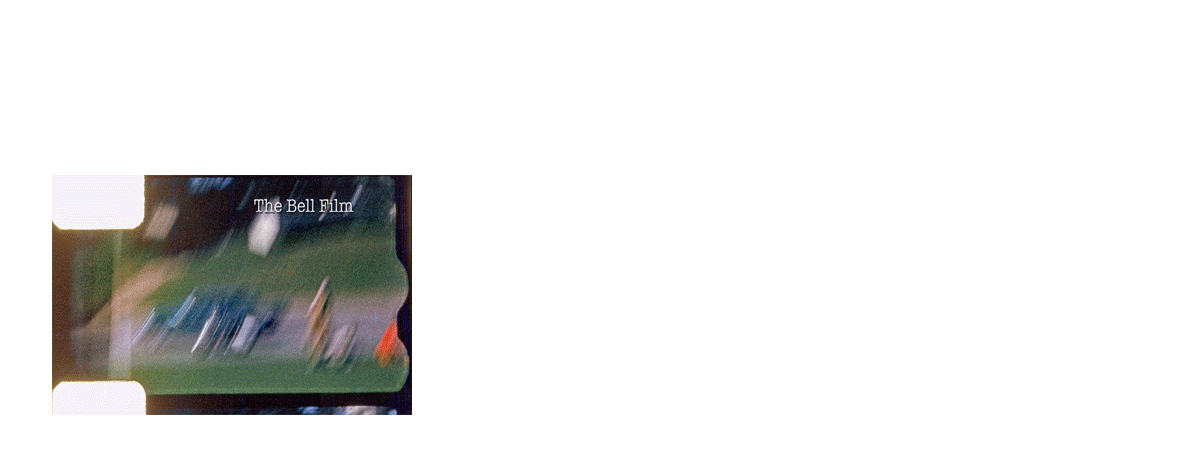
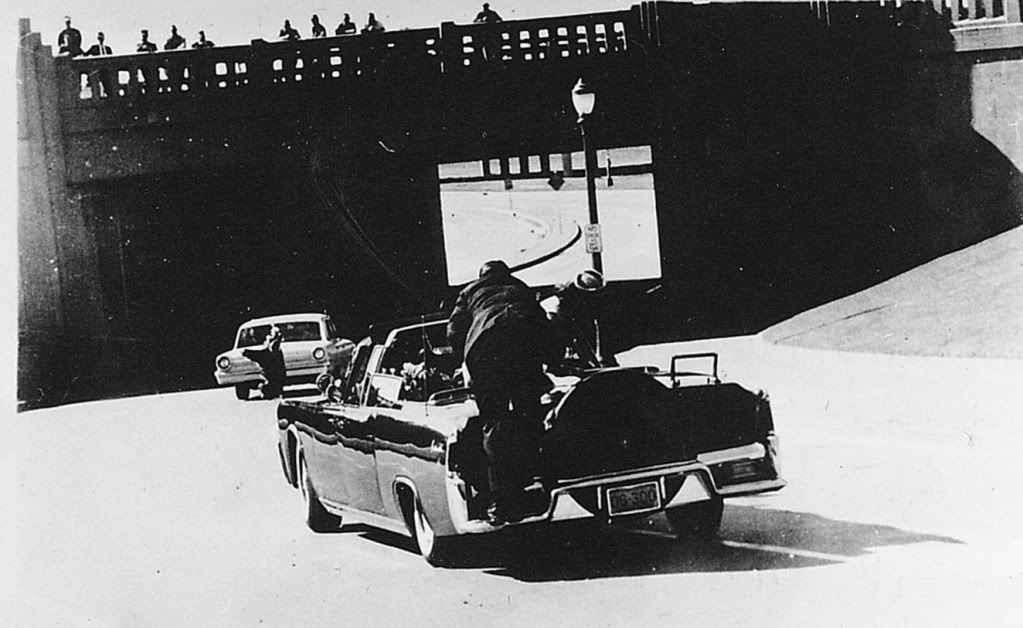
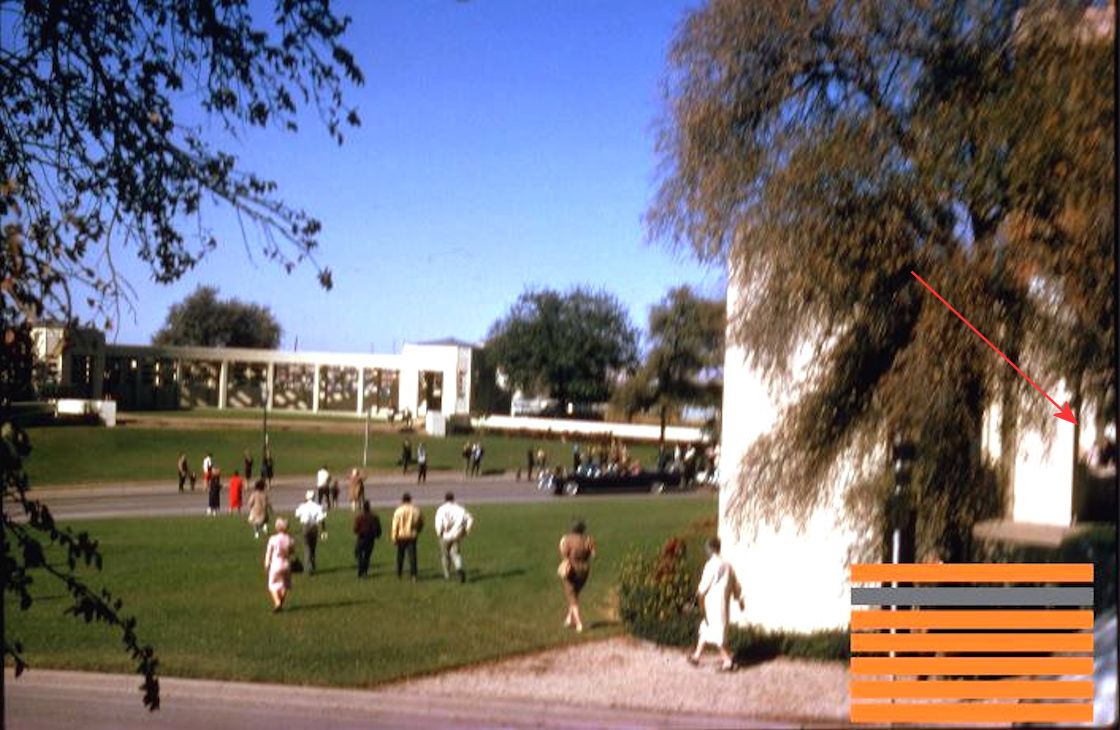
The Motorcade Puzzle
in JFK Assassination Debate
Posted
Its good to see that the adjustment to the Press Pool car has reduced the gap down to around a second. As you say this remaining gap could be either Wiegman delaying his dash, or a need to tighten other events after Bell stops filming. Sadly without more film footage its impossible to say which it is, so for now its probably safer to leave it as it is.
The crucial sync point with that early Couch scene is how it fixes the bikes and people running just as Haygood passes between the two camera cars. The speeds for the people and vehicles feels about right here, but there is always a margin for error as the timing and spatial measurements can never be 100% accurate.